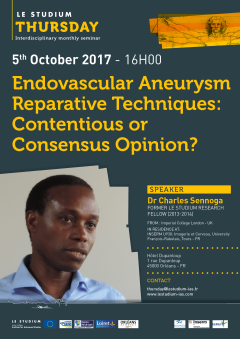Endovascular Aneurysm Reparative Techniques: Contentious or Consensus Opinion?
Hôtel Dupanloup
1 rue Dupanloup
45000 Orléans
France
Presentation
Brain aneurysm repair (BAR) using flow diverting stents (FDs) is a routine procedure in neurovascular interventional medicine. Whereas all clinicians should be able to justify their practice on clinical grounds and audit outcomes, the deployment of FDs aimed at repairing aneurysms presenting at arterial bifurcations can vary between practitioners, and doctors training in BAR may be given conflicting advice. To better identify the preferred approach to BAR provision using FDs for the treatment of bifurcation aneurysms, we are using computation, statistical and radiological examination in order to build virtual and physical representations of idealised and patient-specific aneurysms. This allows us to assess the effectiveness of EVAR using FDs by computing previously un-measurable haemodynamic parameters both before and after treatment. We are then correlating our findings with real-world patient outcomes by prospectively mining patient radiological data (with appropriate approval). Finally, we are using ultrasound imaging to validate our findings by determining haemodynamic changes in true-to-scale patient-specific flow replicas developed in-house. Our findings suggest that there is a threshold bifurcating diameter ratio beyond which, treated with FDs may trigger arterial occlusion or flow complications. Arguments for and against each area of contention will be discussed, and evidence reviewed. Because our study can simulate haemodynamics inducible by alternative deployment scenarios, we believe we can now begin to predict individual patient outcomes. Such finding would be revolutionary in the field of neurovascular disease management and would clearly benefit patients with intracranial aneurysms. In addition, the patient-specific phantoms we have developed and using in our on-going validation studies can allow clinicians to preoperatively perform complex endovascular stent deployment away from the patient thereby reducing the risk of complications.
Speaker
FORMER LE STUDIUM RESEARCH FELLOW (2013-2014)
FROM : Imperial College London - UK
IN RESIDENCE AT: INSERM U930: Imagerie et Cerveau, University François-Rabelais, Tours - FR








